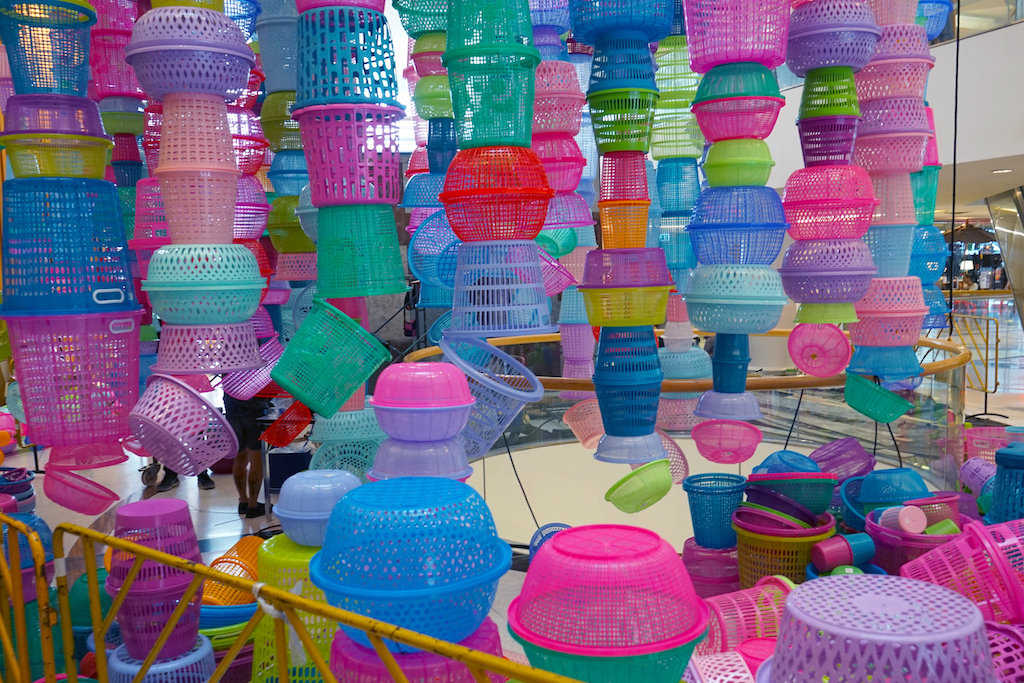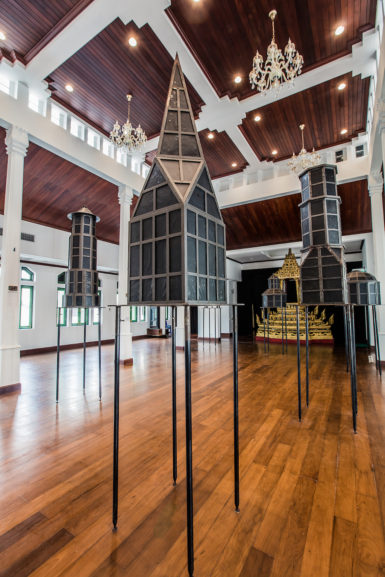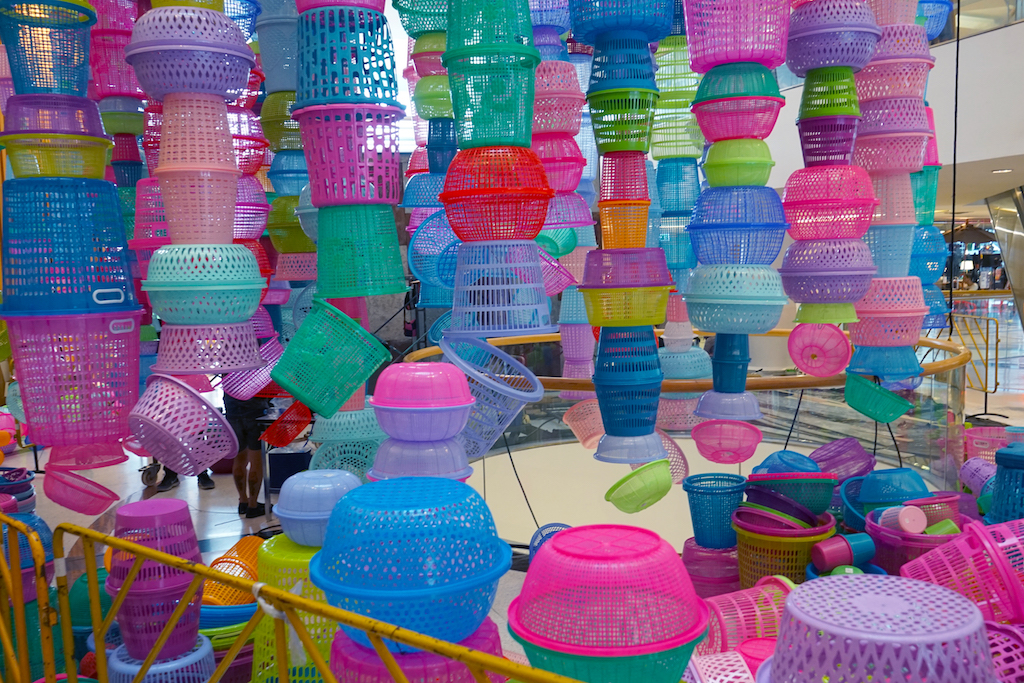[ad_1]

Cheo Jeong Hwa, Basket Tower, 2018.
COURTESY BANGKOK ART BIENNALE
Gridlock on the streets of Thailand’s biggest city makes it difficult to get around to the 20 different sites of the Bangkok Art Biennale, but it does offer plenty of time to mull over impressions of Thai contemporary art while trying. On view through February 3 after opening this past October, the Bangkok Art Biennale is one of three such exhibitions in Thailand over the past year. Last summer was the season for the more underground Bangkok Biennial, whose organizers kept their identities anonymous while they democratically allowed any artist or collective who could afford the costs to set up a pavilion anywhere they wanted. Then in November, the Thailand Biennale opened in the south in Krabi, a decidedly state-run initiative organized by the Office of Contemporary Art and Culture and the Ministry of Culture that situated artworks in outdoor settings.
The Bangkok Art Biennale surpasses them both in terms of ambition and organization as well as sponsorship, with private sponsors including ThaiBev and mall operators the Central Group and Siam Piwat having raised 150 million baht (nearly $5 million) to underwrite the biennale’s first edition. Further corporate pledges have already been made to mount editions in 2020 and 2022 as well.

Montien Boonma, Zodiac Houses, 1998-1999.
COURTESY BANGKOK ART BIENNALE
Apinan Poshyananda, the Bangkok Art Biennale’s chief executive and artistic director, led a team of four curators who selected a lively mix of 75 artists from 33 countries, around half of them Thai and the other half international art stars such as Yayoi Kusama, Marina Abramović, and Elmgreen & Dragset. Sites utilized range from the magnificent Wat Arun (Temple of Dawn) and the colonialist East Asiatic Building to the Mandarin Oriental hotel and the Siam Paragon shopping mall, making for layered and nuanced visits to different parts of Bangkok for those who go to explore.
The biennale’s theme, “Beyond Bliss,” takes a Buddhist approach to human desire and spiritual practice to move beyond ego and greed. In his essay in the show’s catalogue, Poshyananda writes, “At a time when we face anxiety, trauma, and disillusion in an unprecedented way, a simple question was asked—What is happiness and bliss? And how can one maintain, prolong, or overcome desire beyond it?” Much of the work in the exhibition seems to respond to such questions by examining happiness as maybe unachievable in our current age of political discontent. This is especially true of the Thai artists who, despite living in a military dictatorship, freely comment on socio-political issues surrounding them.
Works by 20 artists are on view in the museum setting of the Bangkok Art and Culture Center. Korean artist Cheo Jeong Hwa, whose amazing inflatables can be spotted all around the city, created an apt introduction for the show with Basket Tower (2018), his soaring installation of multi-colored plastic baskets with bells hanging in a six-story high atrium. Mark Justiniani, from the Philippines, contributed his scary Infinity Room-like The Settlement (2016-17), with figures of slaves and prisoners from his country’s past multiplied endlessly within a mirrored space. Australian artist Fiona Hall makes a powerful statement with Forest Floor (2018), a collection of bottles painted to look like bones laid out like skeletons scattered across a darkened gallery. Work by Marina Abramović, who stayed in Bangkok for three weeks in October while supervising endurance performances around the city, remains on view via videos documenting her efforts.
The revelations came from Thai artists. In his video I Have Dreams (2018), Chumpon Apisak poignantly captured the modest hopes of sex workers, who speak on screen of desires to someday own their own businesses and buy a home. The female collective Muslimah is represented by an array of interesting work about Muslim villagers in rural Southern Thailand, especially wooden cutouts of figures engaged in daily activities by group member Kusafiyah Nibuesa. Dow Wasiksiri’s series of photographs titled “Quiet Encounters” (2001–18) documents development on the edge of suburban centers around Thailand in surreal and magical ways.

Muslimah collective.
COURTESY BANGKOK ART BIENNALE
While the museum segment of the biennale was solid, it could not compete with other settings at some of Bangkok’s most renowned ancient sites. Thai artist Montien Boonma matched the magic of the 19th-century Wat Prayoon, Temple of the Iron Gate with his Zodiac Houses (1998-99), freestanding metal constructions that invite viewers to pop their heads inside and see pinholes of light resembling stars. Just outside the baroque Wat Arun, with its stunning central tower encrusted in white porcelain and covered with designs and figures, Sanitas Pradittasnee wrapped a garden area in red plexiglass for Across the Universe and Beyond (2018), creating a sort alternative universe at a dense tourist site. Elmgreen & Dragset set up a gigantic oval zero on a pier looking out at the Chao Praya River, while Korean artist Lee Bul turned a room in the derelict East Asiatic Building into a kaleidoscope of splintered silver forms that transform the space.
Parts of the Bangkok Art Biennale look corporate and commercial in more contemporary sites. Yayoi Kusama’s installation of inflatable pumpkins covered in red polka dots comes off as too decorative in the context of the high-end fashion mall known as Siam Paragon. But at O.P. Place, a shopping center in a colonial-style building, Thai artist Samak Kosem transcends his venue with Nonhuman Ethnography (2017–18), a multimedia installation drawing on research in Thailand’s most southern provinces on the dependency of humans on sheep and ocean waves. Also at O.P. Place, Yuki Kihara, a Samoa-born artist now based in New Zealand, is showing Taualuga: The Last Dance (2006), a haunting video about the indigenous ritual of exhuming bones to connect to ancestral culture.

Chumpon Apisak, I Have Dreams, 2018.
COURTESY BANGKOK ART BIENNALE
The Bangkok Art Biennale is an expansive exhibition that boasts some sites that must have required real patience and resolve to secure, but its relationship to corporate sponsors can be too close for comfort. For example, the shuttered East Asiatic Building being utilized is slated for future development by one of the show’s chief supporters. On the whole, though, the biennial is a great way to appreciate Thai artists in the context of an amazing city. If the show had relegated itself to mere white cubes, half of what it has to say would be lost.
[ad_2]
Source link

